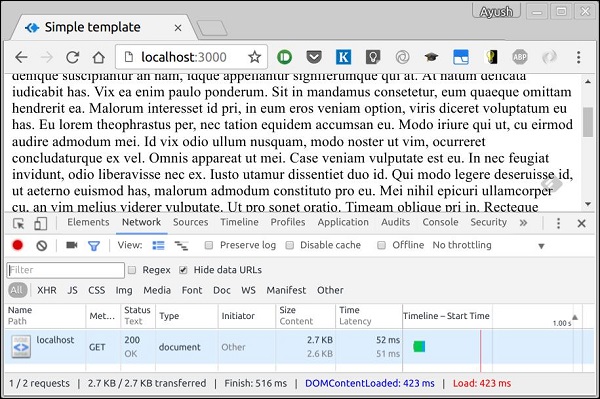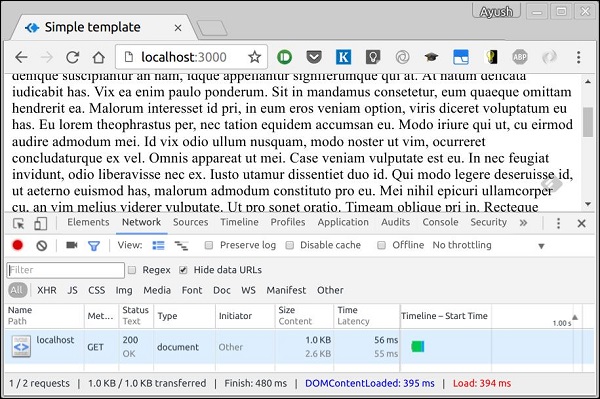
- Koa.js - Home
- Koa.js - Overview
- Koa.js - Environment
- Koa.js - Hello World
- Koa.js - Generators
- Koa.js - Routing
- Koa.js - URL Building
- Koa.js - HTTP Methods
- Koa.js - Request Object
- Koa.js - Response Object
- Koa.js - Redirects
- Koa.js - Error Handling
- Koa.js - Cascading
- Koa.js - Templating
- Koa.js - Form Data
- Koa.js - File Uploading
- Koa.js - Static Files
- Koa.js - Cookies
- Koa.js - Sessions
- Koa.js - Authentication
- Koa.js - Compression
- Koa.js - Caching
- Koa.js - Database
- Koa.js - RESTful APIs
- Koa.js - Logging
- Koa.js - Scaffolding
- Koa.js - Resources
Koa.js - Compression
Compression is a simple, effective way to save bandwidth and speed up your site. It is only compatible with modern browsers and should be used with caution if your users use legacy browsers as well.
When sending responses from the server, if compression is used, it can greatly improve the load time. We'll be using a middleware called koa-compress to take care of the compression of files as well as setting appropriate headers.
Go ahead and install the middleware using −
$ npm install --save koa-compress
Now in your app.js file, add the following code −
var koa = require('koa');
var router = require('koa-router');
var app = koa();
var Pug = require('koa-pug');
var pug = new Pug({
viewPath: './views',
basedir: './views',
app: app //Equivalent to app.use(pug)
});
app.use(compress({
filter: function (content_type) {
return /text/i.test(content_type)
},
threshold: 2048,
flush: require('zlib').Z_SYNC_FLUSH
}));
var _ = router(); //Instantiate the router
_.get('/', getRoot);
function *getRoot(next){
this.render('index');
}
app.use(_.routes()); //Use the routes defined using the router
app.listen(3000);
This puts our compression middleware in place. The filter option is a function that checks the response content type to decide whether to compress. The threshold option is the minimum response size in bytes to compress. This ensures we dont compress every little response.
Following is a response without compression.

Following is the similar response with compression.

If you look at the size tab at the bottom, you can very well see the difference between the two. There is more than 150% improvement, when we compress the files.